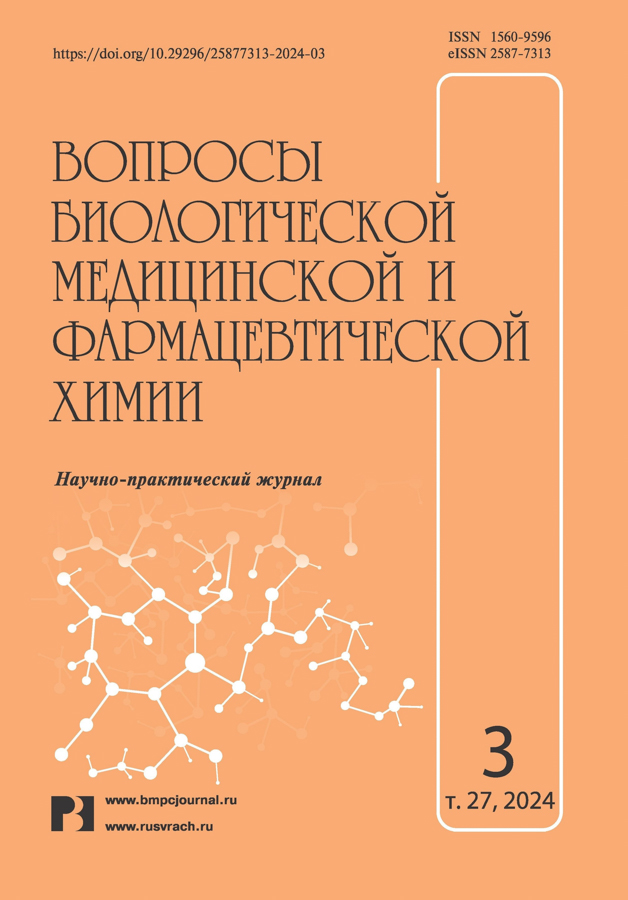The effect of flavonoids on the α-tocopherol compositions antioxidant activity
- 作者: Ilyasov I.R.1, Braun A.V.2, Olicheva V.V.1, Fateenkova O.V.1, Fateenkov V.N.2, Zhevlakova A.K.1, Voskoboynikova I.V.3, Kolkhir V.K.4, Beloborodov V.L.1
-
隶属关系:
- A.P. Nelyubin Faculty of Pharmacy, Sechenov First Moscow State Medical University
- 27 Scientific Center of the Ministry of Defense of the Russian Federation
- JSC "FPC FarmVILAR"
- All-Russian Scientific Research Institute of Medicinal and Aromatic Plants
- 期: 卷 27, 编号 3 (2024)
- 页面: 3-9
- 栏目: Pharmaceutical chemistry
- URL: https://journals.eco-vector.com/1560-9596/article/view/629281
- DOI: https://doi.org/10.29296/25877313-2024-03-01
- ID: 629281
如何引用文章
详细
Introduction. Flavonoids are a family of biologically active substances, representatives of which are often found in the human diet, in particular quercetin, rutin, and morin. When ingested with food, these compounds exhibit their antioxidant properties within the biomolecular system, where α-tocopherol is an important component. Systems formed by antioxidants are characterized by a certain total antioxidant effect, which often differs from the simple sum of their antioxidant capacities to a greater extent in the case of synergy or to a lesser extent in the case of subadditive interaction. From this point of view, the nature of the studied flavonoid's interaction with the endogenous antioxidant α-tocopherol is interesting. The identified interaction effects can serve as a basis for improved antioxidant formulations, as well as the subsequent study of the cooperation mechanisms in vivo.
Aim. The study aims to determine the interaction effects of the α-tocopherol compositions with quercetin, rutin, and morin at their different ratios.
Material and methods. Solutions of individual substances and flavonoid–α-tocopherol compositions in ratios from 1:1 to 1:20 were assessed. The antioxidant capacity was evaluated by the ABTS/PP method, implemented in the form of decolorization and kinetic approaches.
Results. The values of the TEAC index of the studied flavonoids obtained by the decolorization and kinetic method are close and lie in the range of 0.85–3.73 (decolorization) and 0.94–3.22 (kinetic method). Antioxidant capacity increased in the next order: α-tocopherol, rutin, morin, and quercetin. In the first 10 minutes of incubation, flavonoids captured 50–80% of the total number of ABTS•+ radical cations, while α-tocopherol showed the maximum of its antioxidant capacity already in the 1st minute. The composition effects were additive and slightly subadditive for the studied compositions of rutin, morin, and quercetin with α-tocopherol demonstrating maximum values up to –13% in the composition of morin–α-tocopherol 1:10 and quercetin–α-tocopherol 1:20. No dependence of the component’s ratios on the composition effect was found.
Conclusions. The studied compositions of bioflavonoids and α-tocopherol exhibit additive and minor subadditive effects.
关键词
全文:
作者简介
I. Ilyasov
A.P. Nelyubin Faculty of Pharmacy, Sechenov First Moscow State Medical University
编辑信件的主要联系方式.
Email: igor@ilyasov.net
Associate Professor at the Department of Chemistry
俄罗斯联邦, MoscowA. Braun
27 Scientific Center of the Ministry of Defense of the Russian Federation
Email: avbraun@yandex.ru
Ph.D. (Chem.)
俄罗斯联邦, MoscowV. Olicheva
A.P. Nelyubin Faculty of Pharmacy, Sechenov First Moscow State Medical University
Email: olicheva_v_v@student.sechenov.ru
Student
俄罗斯联邦, MoscowO. Fateenkova
A.P. Nelyubin Faculty of Pharmacy, Sechenov First Moscow State Medical University
Email: fateenkova-olga@mail.ru
Post-graduate Student, Department of Chemistry
俄罗斯联邦, MoscowV. Fateenkov
27 Scientific Center of the Ministry of Defense of the Russian Federation
Email: fv08364@gmail.com
Ph.D. (Military Sciences), Associate Professor
俄罗斯联邦, MoscowA. Zhevlakova
A.P. Nelyubin Faculty of Pharmacy, Sechenov First Moscow State Medical University
Email: azh-68@mail.ru
Senior Lecturer at the Department of Chemistry
俄罗斯联邦, MoscowI. Voskoboynikova
JSC "FPC FarmVILAR"
Email: voskoboynikova@pharmvilar.ru
Ph.D. (Pharm.), General Director
俄罗斯联邦, MoscowV. Kolkhir
All-Russian Scientific Research Institute of Medicinal and Aromatic Plants
Email: kolkhir@pharmvilar.ru
Dr.Sc. (Med.), Chief Research Scientist, Department of Experimental and Clinical Pharmacology
俄罗斯联邦, MoscowV. Beloborodov
A.P. Nelyubin Faculty of Pharmacy, Sechenov First Moscow State Medical University
Email: vlbe@list.ru
Dr.Sc. (Pharm.), Professor, Head of the Department of Chemistry
俄罗斯联邦, Moscow参考
- Corcoran M.P., McKay D.L., Blumberg J.B. Flavonoid Basics: Chemistry, Sources, Mechanisms of Action, and Safety. Journal of Nutrition in Gerontology and Geriatrics. Taylor & Francis. 2012; 31(3): 176–189.
- Williams C.A., Grayer R.J. Anthocyanins and other flavonoids. Nat. Prod. Rep. 2004; 21(4): 539.
- Majumdar S., Srirangam R. Potential of the bioflavonoids in the prevention/treatment of ocular disorders. Journal of Pharmacy and Pharmacology. 2010; 62(8): 951–965.
- Cömert E.D., Gökmen V. Chapter Five - Physiological relevance of food antioxidants. Advances in Food and Nutrition Research / ed. Toldrá F. Academic Press. 2020; 93: 205–250.
- Zehiroglu C., Ozturk Sarikaya S.B. The importance of antioxidants and place in today’s scientific and technological studies. J Food Sci Technol. 2019; 56(11): 4757–4774.
- Péter S., Friedel A., Roos F.F. et al. A Systematic Review of Global Alpha-Tocopherol Status as Assessed by Nutritional Intake Levels and Blood Serum Concentrations. International Journal for Vitamin and Nutrition Research. 2015; 85(5–6): 261–281.
- Chen X., Li H., Zhang B. et al. The synergistic and antagonistic antioxidant interactions of dietary phytochemical combinations. Critical Reviews in Food Science and Nutrition. 2022; 62(20): 5658–5677.
- Re R., Pellegrini N., Proteggente A. et al. Antioxidant activity applying an improved ABTS radical cation decolorization assay. Free Radic Biol Med. 1999; 26(9–10): 1231–1237.
- Ilyasov I.R., Beloborodov V.L., Selivanova I.A. Three ABTS•+ radical cation-based approaches for the evaluation of antioxidant activity: fast- and slow-reacting antioxidant behavior. Chem. Pap. 2018; 72(8): 1917–1925.
- Ilyasov I. Beloborodov V., Antonov D. et al. Flavonoids with Glutathione Antioxidant Synergy: Influence of Free Radicals Inflow: 8. Antioxidants. Multidisciplinary Digital Publishing Institute. 2020; 9(8): 695.
补充文件






